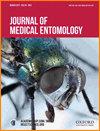完善 Ixodes scapularis(Acari:Ixodidae)分布模型:现行方法与既定规程的比较
IF 2
3区 农林科学
Q1 ENTOMOLOGY
引用次数: 0
摘要
黑腿蜱(Ixodes scapularis Say)是传播 7 种人类病原体的病媒,其中包括导致美国最常见病媒传染病莱姆病的病原体,因此在北美东部构成了巨大的公共卫生风险。物种分布模型是预测黑腿蜱潜在分布和后续风险的一种日益流行的方法,然而,迄今为止,此类模型的开发存在很大差异,使用标准化规程将使其受益匪浅。为了确定标准化规程在哪些方面最有利于当前的分布模型,我们完成了 "概述、数据、模型、评估和预测"(ODMAP)分布模型规程,其中包括 21 份报告 22 种黑脚蜱分布模型的出版物。经计算,平均符合率为 73.4%(SD ± 29%)。最突出的一点是,我们发现作者可以更好地证明他们所选择的变量和相关空间尺度与黑脚蜱生态学之间的联系。此外,作者还可以对模型的建立进行更清晰的描述,包括对多重共线性、空间自相关性和合理性的检查。最后,作者可以改进对变量效应的报告,以避免削弱模型在提供物种-环境关系信息方面的效用。为了提高未来模型的严谨性和可重复性,我们建议利用包括 ODMAP 协议在内的多种资源,并建议期刊将遵守协议作为发表论文的先决条件。本文章由计算机程序翻译,如有差异,请以英文原文为准。
Refining Ixodes scapularis (Acari: Ixodidae) distribution models: a comparison of current methods to an established protocol
Blacklegged ticks (Ixodes scapularis Say) pose an enormous public health risk in eastern North America as the vector responsible for transmitting 7 human pathogens, including those causing the most common vector-borne disease in the United States, Lyme disease. Species distribution modeling is an increasingly popular method for predicting the potential distribution and subsequent risk of blacklegged ticks, however, the development of such models thus far is highly variable and would benefit from the use of standardized protocols. To identify where standardized protocols would most benefit current distribution models, we completed the “Overview, Data, Model, Assessment, and Prediction” (ODMAP) distribution modeling protocol for 21 publications reporting 22 blacklegged tick distribution models. We calculated an average adherence of 73.4% (SD ± 29%). Most prominently, we found that authors could better justify and connect their selection of variables and associated spatial scales to blacklegged tick ecology. In addition, the authors could provide clearer descriptions of model development, including checks for multicollinearity, spatial autocorrelation, and plausibility. Finally, authors could improve their reporting of variable effects to avoid undermining the models’ utility in informing species–environment relationships. To enhance future model rigor and reproducibility, we recommend utilizing several resources including the ODMAP protocol, and suggest that journals make protocol compliance a publication prerequisite.
求助全文
通过发布文献求助,成功后即可免费获取论文全文。
去求助
来源期刊
CiteScore
4.60
自引率
14.30%
发文量
207
审稿时长
3-8 weeks
期刊介绍:
Journal of Medical Entomology is published bimonthly in January, March, May, July, September, and November. The journal publishes reports on all phases of medical entomology and medical acarology, including the systematics and biology of insects, acarines, and other arthropods of public health and veterinary significance. In addition to full-length research articles, the journal publishes Reviews, interpretive articles in a Forum section, Short Communications, and Letters to the Editor.

 求助内容:
求助内容: 应助结果提醒方式:
应助结果提醒方式:


